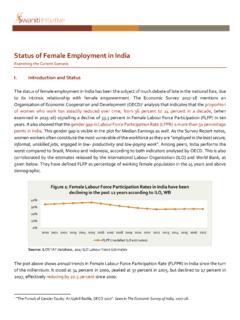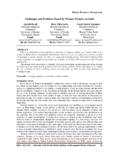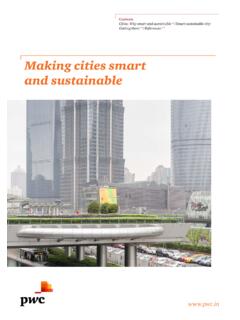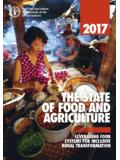Transcription of POVERTY IN INDIA: MEASUREMENT, TRENDS AND …
1 WP-2020-038 POVERTY IN india : measurement , TRENDS AND OTHERISSUESC. Rangarajan and S. Mahendra DevIndira Gandhi Institute of Development Research, MumbaiDecember 2020 POVERTY IN india : measurement , TRENDS AND OTHERISSUESC. Rangarajan and S. Mahendra DevEmail(corresponding author): of POVERTY is an important objective of economic policy. Therefore, measurement of povertyhas to be sound as it has significant policy implications. This paper presents the methodology followedby the Expert Group (Rangarajan) and explains some of the issues that were raised after the publicationof the Report. Apart from the methodology, some of the issues discussed in the paper are: use ofcalories, multi-dimensional POVERTY , urban POVERTY , NAS (National Accounts Statistics)-NSS (NationalSample Survey) consumption differences, POVERTY measures in other countries, public expenditure andpoverty, NSS and SECC (socio-economic caste census), headcount and depth of POVERTY , inequality andpoverty and, criteria for eligibility under methodology adopted by the new group on POVERTY is based on sound principles.
2 However, as thegroup has clearly indicated, this measure is not considered as an appropriate basis for determiningentitlements under various programmes. But to obtain a general picture of the progress of the country, asuitable measure on POVERTY is useful. It represents absolute minimum. Obviously, policy should worktowards not only to reduce the number of people below that line but also ensure that people in generalenjoy a much higher standard of living. Policy makers must continue to follow the two-fold strategy ofletting the economy grow fast and attacking POVERTY directly through POVERTY alleviation programmes. Keywords: POVERTY line; POVERTY ratio; multi-dimensional POVERTY ; POVERTY alleviationprogrammes; measurement of POVERTY .
3 JEL Code: I31; I32, I381 POVERTY IN india : measurement , TRENDS AND OTHER ISSUES C. Rangarajan and S. Mahendra Dev 1. Introduction Growth is not the sole objective of economic policy. It is necessary to ensure that the benefits of growth accrue to all sections of the society. Eradication of POVERTY is thus an important objective. Human beings need a certain minimum consumption of food and non-food items to survive. However, the perception regarding what constitutes POVERTY varies over time and across countries. Nevertheless, there is need for a measure of POVERTY . Only then, it will be possible to evaluate how the economy is performing in terms of providing a certain minimum standard of living to all its citizens. measurement of POVERTY has, therefore, important policy implications.
4 This paper presents the methodology followed by the Expert Group (Rangarajan) and explains some of the issues that were raised after the publication of the Report. There are in fact many approaches for measuring POVERTY . Some analysts focus on deprivations of people in terms of health, education, sanitation or housing. There are, however, many problems associated with this approach including difficulties in aggregating deprivations on several scores derived from different sources. Perhaps the best approach is look at it in terms of certain minimum consumption expenditure per person or preferably per household. Any household failing to meet this level of consumption expenditure can be treated as a poor household. This minimum level of consumption expenditure can be derived, in turn, in terms of minimum expenditure on food and non-food items.
5 The POVERTY ratio, which is the ratio of number of poor to the total population is expressed as percentage. It is also known as HCR (head-count ratio). The POVERTY ratio is measured from an exogenously determined POVERTY line quantified in terms of per capita consumption expenditure over a month and the class distribution of persons obtained from the large sample survey of consumer expenditure data of the National Sample Survey Office (NSSO). 2 In india , we have had a long history of studies on measurement of poverty1. The methodology for estimation of POVERTY used by the Planning Commission has been based on the recommendations made by Working Group/Task Force/Expert Groups consisting of eminent experts in the field.
6 The Planning Commission has constituted these Groups from time to time to revisit the methodological issues related to the measurement of POVERTY so as to make the estimates more relevant to the contemporary economic situation. After the Working Group of the Planning Commission delineated the methodology of POVERTY estimation in 1962, it has been intensely debated by the academicians, experts, policy planners, etc., over the years. In response, the Planning Commission has constituted Task Force/ Expert Group from time to time to review the methodology. These include the Task Force under the chairmanship of Alagh in 1977; the Expert Groups under the chairmanship of Lakdawala in 1989 and Tendulkar in 2005.
7 In June 2012, the Government of india (GoI) appointed an Expert Group (C. Rangarajan as Chairman) to take a fresh look at the methodology for the measurement of POVERTY . The Committee submitted its report towards the end of June 2014. 2. Approaches of the Earlier Committees The Planning Commission is the nodal agency in the GoI for estimation of POVERTY and these estimates are based on the recommendations of the committees appointed by it. Before going to the Expert Group (Rangarajan), the approaches of earlier committees on estimation of POVERTY are described below. The Working Group 1962 recommended that the national minimum consumption expenditure for a household of five persons (four adult consumption units) should not be less than `100 per month or `20 per capita per month in terms of 1960-61 prices.
8 For urban areas, this figure was `125 per month or `25 per capita per month to cover the higher prices there. The POVERTY line excluded expenditure on health and 1 Srinivasan (2007) reviews the evolution of POVERTY lines in india from a historical perspective and critically discusses some issues relating to official POVERTY lines. Srinivasan (2013), among other things, discusses about POVERTY lines in india in the recent past. 3 education, both of which, it was assumed, were to be provided by the State. The Working Group (1962) appeared to have taken into account the recommendation of balanced diet made by the Nutrition Advisory Group of the Indian Council of Medical Research (ICMR) in 1958.
9 This POVERTY line was widely used in the 1960s and 1970s to estimate the POVERTY ratio at national and state level. Task Force 1979 (Alagh) (GoI, 1979) estimated average calorie requirements and the POVERTY line corresponding to the calorie requirement. The estimated calorie norm was 2400 kcal per capita per day in rural areas and 2100 kcal per capita per day in urban areas. To work out the monetary equivalent of these norms, 28th Round (1973- 74) NSS data relating to household consumption both in quantitative and value terms were used. Based on the observed consumer behaviour in 1973-74 it was estimated that, on an average, consumer expenditure (food and non-food) of ` per capita per month was associated with a calorie intake of 2400 per capita per day in rural areas and ` per capita per month with a calorie intake of 2100 per day in urban areas.
10 The NSS distribution of private consumption was adjusted pro-rata to correspond to the consumption estimates of National Accounts Statistics (NAS) made by the Central Statistical Office (CSO). Using the POVERTY line and the adjusted distribution of persons by expenditure classes for the reference year the percentage of persons below the POVERTY line was estimated. The POVERTY line defined by the Task Force at 1973-74 prices was updated by the Planning Commission (to estimate POVERTY for a later year) using the implicit Central Statistical Office (CSO) private consumption expenditure deflator. Planning Commission appointed Expert Group (Lakdawala) in 1989 which submitted its report in 1993 (GoI, 1993). The Expert Group (Lakdawala) did not redefine the POVERTY line.











